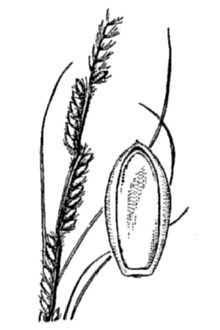Paspalum sericeum Scheele
Scientific Name: Paspalum sericeum Scheele

| General Information | |
|---|---|
| Usda Symbol | PASE12 |
| Group | Monocot |
| Life Cycle | Perennial |
| Growth Habits | Graminoid |
| Native Locations | PASE12 |
Plant Guide
Uses
Texas cupgrass is a highly palatable forage grass (Gould, 1975). It is readily eaten year round by all classes of livestock. It can be used as a component in native range restoration projects.
Status
Please consult the PLANTS Web site and your State Department of Natural Resources for this plant’s current status (e.g. threatened or endangered species, state noxious status, and wetland indicator values).
Description
General: Texas cupgrass (Eriochloa sericea) is a tufted, warm-season, perennial grass that grows 3 to 3 ½ feet in height (Correll & Johnston, 1996). This erect grass is a member of the Paniceae tribe of grasses (Hitchcock, 1971). There is no known commercial variety of Texas cupgrass. Distribution: For current distribution, please consult the Plant Profile page for this species on the PLANTS Web site. Habitat: Texas cupgrass grows mostly on well-drained prairies, and brushy, rocky slopes with tight loamy soils (Correll & Johnston, 1996).
Adaptation
Texas cupgrass is found in Oklahoma, Texas, and Northern Mexico (Gould, 1975). In Texas, it can be found in North Central Texas, the eastern portion of the Rolling Plains, south to the eastern part of the Edwards Plateau and the the Rio Grande Plains, and rarely on a few sites in East Texas (Correll & Johnston, 1996). It prefers clay and clay loam soils (Hatch, Schuster, & Drawe, 1999).
Establishment
Texas cupgrass can be grown from seed. A 1990 germination test conducted by the Kika de la Garza Plant Material Center staff yielded 50 percent germination. A second germination test conducted in the summer of 2000, yielded approximately 40% germination after only 14 days at 20°C for 12 hours of darkness and 30ºC for 12 hours of light.
Management
Texas cupgrass survives only under moderate grazing pressure (Gould, 1975). It will persist in overgrazed pastures only under the protection of shrubs (Hatch, Schuster, & Drawe, 1999). Texas cupgrass is an indicator of good range condition. It is seldom a key management species; however, because it rarely dominates a site.
Seeds and Plant Production
Plant Production , Use soil moisture sensors to measure the soil moisture of Paspalum sericeum Scheele.
Plant Production
Texas cupgrass has several problems from a seed production standpoint. First of all, some of the taller plants tend to lodge, which makes harvesting seed a problem. Second, seed retention is poor. Seed shatter tends to occur fairly rapidly after the seed has ripened making it difficult to harvest a stand because all the heads do not ripen at once. Third, there appears to be an ongoing problem with spittlebugs on the seed heads, which decreases the quantity of viable seed. Finally, Texas cupgrass appears to be susceptible to smut on the seed heads, a problem which can also affect seed quality.
Fact Sheet
Uses
Texas cupgrass is a highly palatable forage grass. It is readily eaten year round by all classes of livestock. It can be used as a component in native range restoration projects.
Status
Please consult the PLANTS Web site and your State Department of Natural Resources for this plant’s current status (e,g, Use soil moisture sensors to measure the soil moisture of Paspalum sericeum Scheele., threatened or endangered species, state noxious status, and wetland indicator values),
Description
Texas cupgrass (Eriochloa sericea) is a tufted, warm-season, perennial grass that grows 3 to 3 ½ feet in height. This erect grass is a member of the Paniceae tribe of grasses. There is no known commercial variety of Texas cupgrass.
Adaptation
Texas cupgrass is found in Oklahoma, Texas, and Northern Mexico. In Texas, it can be found in North Central Texas, the eastern portion of the Rolling Plains, south to the eastern part of the Edwards Plateau and the the Rio Grande Plains, and rarely on a few sites in East Texas. It prefers clay and clay loam soils. Texas cupgrass grows mostly on well-drained prairies, and brushy, rocky slopes with tight loamy soils. For a current distribution map, please consult the Plant Profile page for this species on the PLANTS Website.
Establishment
Texas cupgrass can be grown from seed. A 1990 germination test conducted by the Kika de la Garza Plant Material Center staff yielded 50 percent germination. A second germination test conducted in the summer of 2000, yielded approximately 40% germination after only 14 days at 20°C for 12 hours of darkness and 30ºC for 12 hours of light.
